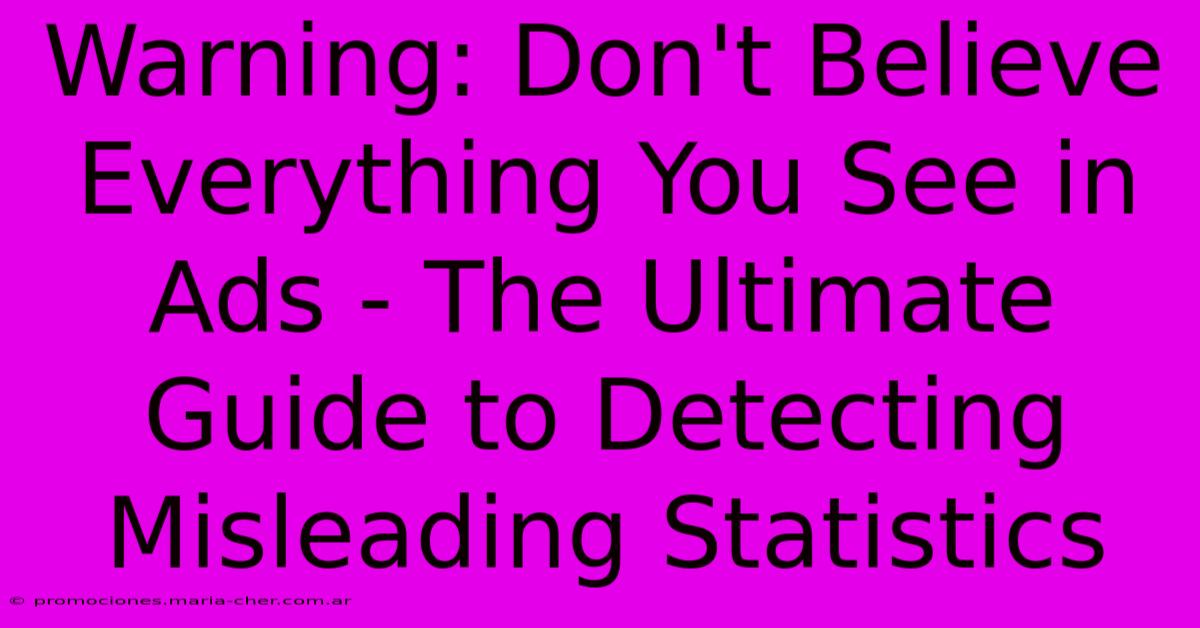Warning: Don't Believe Everything You See In Ads - The Ultimate Guide To Detecting Misleading Statistics

Table of Contents
Warning: Don't Believe Everything You See in Ads - The Ultimate Guide to Detecting Misleading Statistics
In today's digital age, we're bombarded with advertisements—a constant stream of flashy images, compelling narratives, and, most importantly, statistics. These numbers are often presented as irrefutable proof of a product's efficacy, a service's superiority, or a cause's urgency. But beware! Many ads employ misleading statistics to manipulate our perceptions and influence our purchasing decisions. This guide provides you with the tools to critically examine advertising claims and avoid being swayed by deceptive data.
Why Are Misleading Statistics Used in Advertising?
Advertisers know that numbers hold weight. They convey a sense of authority and objectivity, making claims seem more credible than mere assertions. However, manipulating statistics allows companies to:
- Exaggerate Results: Presenting data out of context or using cherry-picked examples can inflate the apparent success of a product or service.
- Hide Negative Information: Key details that contradict the positive narrative are often omitted, creating a skewed picture.
- Confuse Causation and Correlation: A correlation between two factors doesn't necessarily mean one causes the other. Ads often exploit this confusion to link their product to positive outcomes.
- Target Specific Demographics: Certain statistics might resonate more with particular audiences, leading to tailored misleading campaigns.
Common Tactics of Misleading Advertising Statistics:
Here are some common tricks to watch out for:
1. Unspecified Baselines and Comparisons:
- The Problem: Ads might boast about a product being "50% better." But better than what? Without a clear baseline, this claim is meaningless.
- The Solution: Always ask: "Better than what? Compared to whom?" Look for specific details about the comparison group and the metric used.
2. Vague or Ambiguous Language:
- The Problem: Terms like "clinically proven," "scientifically tested," or "up to X% improvement" are often vague and lack specific details.
- The Solution: Demand clarity. What was the specific test? What was the sample size? What were the specific results?
3. Misrepresentation of Percentages and Averages:
- The Problem: Averages can be misleading, especially when outliers heavily skew the data. For instance, an "average" customer satisfaction rating might be boosted by a small group of extremely satisfied customers while ignoring a large number of negative reviews.
- The Solution: Look beyond simple averages. Seek median and range information to understand the complete picture. Consider reading reviews or testimonials from a larger sample pool.
4. Selective Data Presentation (Cherry-Picking):
- The Problem: Only highlighting positive results while ignoring negative ones creates a biased picture.
- The Solution: Look for the full data set. If it's not available, be skeptical. Reputable companies will readily provide more detailed information upon request.
5. Using Visual Distortions to Misrepresent Data:
- The Problem: Graphs and charts are often manipulated to exaggerate differences or obscure negative trends. Pay close attention to the axis scaling and the overall presentation.
- The Solution: Carefully examine the visual elements of any charts presented. Are the scales manipulated? Is the graph accurately representing the data?
How to Protect Yourself from Deceptive Advertising Statistics:
- Be Skeptical: Don't blindly accept claims at face value.
- Look for Sources: Reputable ads will often cite the sources of their data. Verify this information.
- Read the Fine Print: Small details often reveal crucial information.
- Cross-Reference Information: Check multiple sources before making a decision.
- Report Misleading Ads: Many organizations actively work to combat deceptive advertising practices.
By understanding the common tactics used in misleading advertising statistics, you can equip yourself to critically evaluate claims and make informed decisions, protecting yourself from deceptive marketing practices. Don't let numbers fool you!

Thank you for visiting our website wich cover about Warning: Don't Believe Everything You See In Ads - The Ultimate Guide To Detecting Misleading Statistics. We hope the information provided has been useful to you. Feel free to contact us if you have any questions or need further assistance. See you next time and dont miss to bookmark.
Featured Posts
-
Your Office Your Way Discover The Advantages Of Hourly Office Rental In Nyc The Ultimate Workspace Solution
Feb 08, 2025
-
Floral Fiesta Wholesale Let Babys Breath Take Center Stage
Feb 08, 2025
-
Financial Freedom Awaits The Stock Warrants List That Will Propel You To Success
Feb 08, 2025
-
Pink Quartz Birthstone A Guide To Its Healing Energy Spiritual Connections And Practical Uses
Feb 08, 2025
-
Uncover The Secret Goldmine The Ultimate Stock Warrants List For Limitless Profits
Feb 08, 2025
